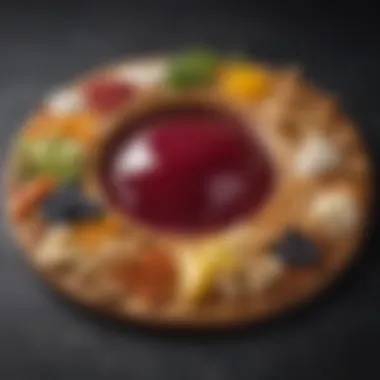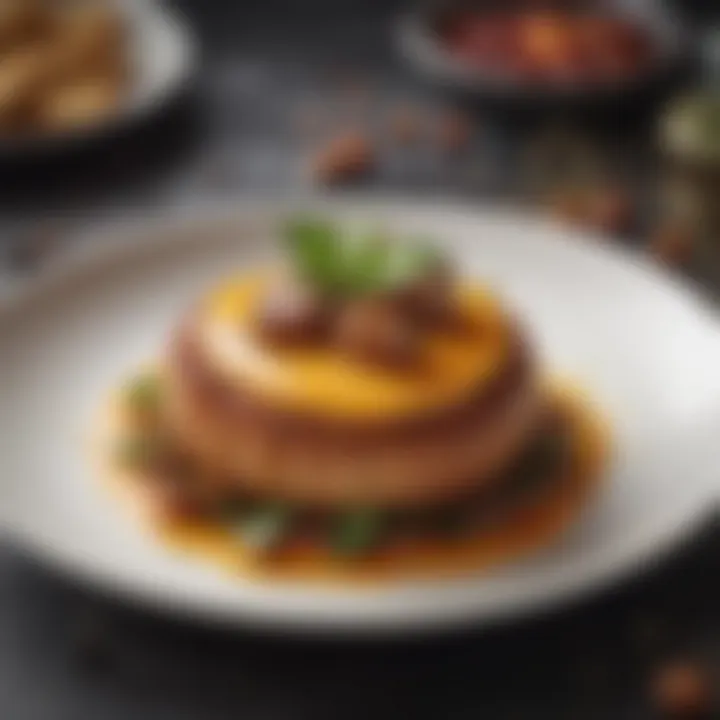Exploring the Intricacies of Halo Flavours


Intro
In the realm of gastronomy, the term halo flavours has become increasingly significant. These are not just typical tastes. They represent a unique class of flavours that possess the ability to enhance one another. This article explores the concept of halo flavours, their origins, culinary significance, and how they work together to elevate dishes.
Understanding halo flavours can significantly impact both amateur cooks and seasoned chefs. By recognizing which flavours naturally pair well, cooks can create more balanced and enjoyable dishes.
Recipe Overview
Recipe Name
Herb-Infused Lemon Chicken
Description of the Dish
This dish combines the brightness of lemon with the aromatic depth of various herbs. The presence of lemon acts as a halo flavour, complementing herbs like thyme, rosemary, and basil, thereby creating a cohesive and aromatic profile. This recipe not only highlights the beauty of halo flavours but also lays a foundation for creative culinary ventures.
Ingredients
- 4 boneless, skinless chicken breasts
- 1/4 cup fresh lemon juice
- 3 tablespoons olive oil
- 1 tablespoon fresh thyme, chopped
- 1 tablespoon fresh rosemary, chopped
- 1 tablespoon fresh basil, chopped
- Salt and pepper to taste
- Lemon slices for garnish
Special Notes on Ingredients
- Substitutions: If fresh herbs are unavailable, dried versions can be used. However, the flavor intensity may vary.
- Regional Variants: In certain regions, replacing lemon with grapefruit can add an interesting twist to the dish.
Incorporating halo flavours into everyday preparation allows for exciting culinary experiments, further unlocking the potential within common ingredients. The foundations laid in this recipe can inspire a multitude of variations, adapting to personal preferences while embracing the essence of halo flavours.
By understanding the properties of halo flavours, one can enhance not just individual dishes but the entire dining experience.
As we delve deeper into the science and applications of halo flavours, the potential for creativity in the kitchen expands, offering food lovers a pathway to richer and more satisfying meals.
Prologue to Halo Flavours
Halo flavours have emerged as a significant concept within culinary discussions, underpinning the way dishes are crafted and experienced. The importance of understanding halo flavours lies in their ability to enhance food by creating harmonious combinations that appeal to the palate. A strong grasp of halo flavours can transform a mundane meal into an extraordinary one, engaging both the senses and the emotions.
At the core of halo flavours is the idea that certain flavours complement each other in a way that elevates the overall dining experience. This synergy can lead to dishes that are more satisfying and enjoyable. While some may consider cooking an art, at its foundation lies the science of flavour pairing, which aids chefs and home cooks alike in their culinary endeavors.
When delving into the concept of halo flavours, it is crucial to recognize that they are not merely a theoretical construct but rather a practical tool in the kitchen. Mastering the identification and application of halo flavours can provide a myriad of benefits, including improved taste, increased creativity in recipe development, and the ability to cater to diverse dietary preferences. As we explore this topic further, we will uncover various dimensions of flavour pairing, ranging from technical aspects to cultural influences, enriching our understanding of how flavours can work together in harmony.
Defining Halo Flavours
Halo flavours refer to a specific phenomenon in culinary arts where certain flavours enhance one another, leading to a more profound taste experience. The primary essence of halo flavours lies in their ability to create a stronger overall flavour impression when used in combination rather than in isolation.
For instance, combining elements like basil with tomatoes or chocolate with raspberry can produce a distinct burst of flavour that may not be possible when these ingredients are used separately. Often, these pairings have been discovered over time and are influenced by regional cuisines or cultural practices.
Historical Context of Flavour Pairing
The historical context of flavour pairing is rich and varied. Throughout history, different cultures have utilized local ingredients and their innate properties to create dishes that are remarkably flavourful. Ancient civilizations understood the relationships between certain flavours instinctively, which shaped traditional dishes.
For example, consider the ancient practice in Chinese cuisine, where complementary flavours were meticulously balanced to promote health and well-being. In contrast, Mediterranean cuisine often showcases vibrant combinations of herbs and spices that excite the senses and complement the fresh produce of the region.
In contemporary times, culinary artists have revisited these historical insights to refine and innovate flavour pairings. This blending of old and new ideas encourages culinary exploration that respects tradition while pushing past the boundaries of conventional flavour combinations. Understanding this rich history allows cooks to appreciate the depth of flavour foundations upon which modern gastronomy rests.
The Science Behind Halo Flavours
Understanding the science behind halo flavours is crucial for grasping their role in culinary practices. Halo flavours refer to taste elements that enhance one another when paired. Studying this concept deepens knowledge about taste pairings and ingredients, making cooking more enjoyable and effective.


This section will explore the chemical interactions and psychological aspects of taste perception, revealing how science collaborates with culinary arts.
Chemical Interactions of Flavours
The chemical makeup of flavours determines how they interact. Each ingredient consists of various volatile compounds. These compounds react when mixed, leading to unique outcomes. The synergy of flavours occurs through molecular interactions. For instance, the pairing of sweet basil with tomatoes releases compounds that boost both flavours, making them vibrant.
Some key elements include:
- Esters: Deliver fruity notes, commonly found in many herbs and fruits.
- Phenols: Add structure and depth, providing complexity to taste.
- Terpenes: Found in citrus, they offer freshness and brightness.
When understood correctly, these chemical interactions lead to better dish creation. Recognition of how specific flavours affect one another helps cooks make informed choices while selecting ingredients.
Psychological Aspects of Taste Perception
Taste perception is not just physiological but also psychological. Our past experiences play a significant role. For example, a person who grew up eating spicy food might respond more positively to fiery flavours than someone with a milder upbringing.
Several aspects influence how we perceive tastes:
- Cultural Background: Different cultures develop unique flavour preferences which shape culinary identities.
- Presentation: Visual appeal impacts taste perception. A beautifully plated dish could enhance enjoyment.
- Context: Eating environment, such as a cozy home versus a busy restaurant, can alter taste experience.
"Taste is an impression, informed by societal norms, personal experiences, and the senses involved in the eating process."
These psychological layers add depth to the artistic aspect of cooking. As chefs explore halo flavours, they should also consider the mental effects of presentation and context on diners. This broader understanding allows for a richer culinary experience.
Cultural Perspectives on Halo Flavours
Understanding halo flavours requires looking through a cultural lens. The way people perceive and enjoy flavors varies significantly across the globe. Each culture brings unique elements to the culinary landscape, shaping preferences and cooking techniques. This aspect of halo flavours highlights the importance of context in gastronomy. Different regions have developed their own practices over centuries, often based on local ingredients and traditions. Thus, the exploration of cultural perspectives on halo flavours is not only enlightening but also essential for appreciating their complexity.
Regional Differences in Flavour Preferences
Regional differences in flavour preferences illustrate how diverse culinary practices can be. For instance, in Italy, there is great emphasis on fresh ingredients and natural tastes. Here, you often find a harmonious blend of sweet, salty, and savory, with basil and tomatoes working together to create balanced dishes. In contrast, Asian cuisines, particularly in countries like Thailand and India, favor a whole spectrum of bold spices. Sweetness, saltiness, and sourness intermingle, creating vibrant dishes that contrast sharply with the subtleties of Italian fare.
The subtleties in flavour preferences can be categorized into several key elements:
- Ingredient Availability: What is available locally often shapes the flavours that define a culture. For example, proximity to the sea influences coastal cuisines with a focus on fresh seafood.
- Cultural Traditions: Festivities often dictate certain food rituals, exposing individuals to specific flavours repeatedly, building a strong cultural association.
- Historical Influences: Colonial history and trade routes introduce new flavours to a region. For example, spices introduced to Europe during the age of exploration became integral to many western dishes.
Fusion Cuisine and Halo Flavours
Fusion cuisine demonstrates the adaptive nature of halo flavours across cultures. By blending two or more culinary traditions, chefs create a unique taste experience that transcends geographical boundaries. This innovation can lead to remarkable dishes that highlight the essence of halo flavours. For instance, the pairing of Japanese and Peruvian cuisine has opened pathways for new interpretations of sushi and ceviche. This melding is a testament to how cultures can influence each other through food.
Several aspects characterize fusion cuisine and its approach to halo flavours:
- Creativity: Chefs experiment with unexpected combinations, pushing the boundaries of traditional dishes.
- Culinary Dialogue: By merging distinct culinary techniques, there is a sharing of cultural stories through food, enriching the dining experience.
- Market Trends: Globalization has increased the availability of diverse ingredients, allowing more kitchens to explore fusion possibilities.
Incorporating halo flavours into fusion dishes requires sensitivity to balance. An overloaded dish might overwhelm the senses rather than enhance the experience. The goal here is to create layers of taste that respect each origin's true essence while producing something entirely new.
Practical Applications in the Kitchen
Understanding practical applications of halo flavours is essential for both amateur home cooks and experienced chefs alike. This concept not only enhances the overall culinary experience but also allows for greater creativity and versatility in cooking. Halo flavours act as a guide, helping to identify which taste notes complement each other in various dishes. By grasping this practice, cooks can elevate their meals to achieve deeper and more satisfying palates.
How to Identify Halo Flavours
Identifying halo flavours requires an intricate balancing act of sensory perception and appreciation of food pairing. The first step is to become aware of the base flavours in your ingredients. Common base flavours include sweet, salty, acidic, bittersweet, and umami.
- Employ Taste Tests: Cook with a few different ingredients while focusing on distinct flavour profiles. Taste-testing helps refine your palate.
- Consider Regional and Cultural Pairings: Exploring traditional pairings can provide insights into effective combinations. For instance, balancing citrus with seafood is prevalent in Mediterranean cuisine.
- Documentation: Keeping a flavour journal may help in recognizing patterns in flavour combinations. Note down what works and what doesn’t.
The more you experiment, the more intuitive identifying halo flavours becomes. This practice can lead to innovative dishes.


Techniques for Combining Flavours
When it comes to combining flavours, techniques play a critical role. The process often involves several methods that enhance synergy between ingredients.
- Layering Flavours: Start with foundational tastes, and build up to complexity. For instance, use herbs to introduce fragrant notes before adding a second type of spice.
- Acidity Balancing: Acidic components can elevate dishes by cutting through richness. Incorporating lime or vinegar can make a heavy dish more vibrant.
- Texture Variations: Varying textures can create an interesting contrast. For example, pairing crispy elements against softer components invites a more engaging eating experience.
These methods not only help in glorying halo flavours but also contribute to an overall harmonious dish.
Creating Balanced Dishes with Halo Flavours
Creating balanced dishes with halo flavours is a crucial skill for any cook. This involves ensuring that no single flavour overwhelms the others, allowing each element to shine through.
- Start with a Base: Begin with a base ingredient that will take the lead in the dish. This can be a protein or a vegetable that resonates with the flavours being highlighted.
- Incorporate Complementary Elements: Add ingredients that echo the main flavour while enhancing it mildly. For instance, a creamy sauce can pair well with grilled chicken seasoned with herbs.
- Taste and Adjust: Continuously taste throughout the cooking process. Adjust levels of salt, acidity, or sweetness as needed.
A balanced dish invites the diner on a culinary journey, where every bite unfolds layers of flavour that together create a delightful experience.
By applying these techniques, you can effortlessly leverage halo flavours, forming dishes that are well-rounded and delicious.
Halo Flavours Across Different Cuisines
The exploration of halo flavours across different cuisines sheds light on how culinary traditions utilize these flavour relationships to create impactful dishes. Halo flavours can enhance taste experiences by allowing certain ingredients to flourish in the presence of others. Understanding these pairings provides insight into regional preferences and practices, fostering the appreciation of diverse culinary heritages.
Italian Cuisine and Halo Flavours
Italian cuisine exemplifies the concept of halo flavours through its careful pairing of ingredients. The Italian kitchen often relies on a few key components, such as tomatoes, basil, and olive oil. When combined, these flavours elevate each other. For instance, the sweetness of ripe tomatoes balances the peppery notes of fresh basil, creating a harmonious dish that showcases the principle of halo flavours.
Dishes like Caprese salad demonstrate this concept clearly. Here, the simple pairing of mozzarella, tomatoes, and basil highlights the union of flavours that contribute to a fresh and satisfying taste profile. Furthermore, sauces like Marinara derive their depth from layering flavours, where garlic, onion, and herbs are added to enrich the overall taste.
Using halo flavours in pasta sauces not only enhances the dish but also provides a clear representation of Italian culinary philosophy, where simplicity and quality ingredients merge to create depth in flavour.
Asian Cuisine Applications
Asian cuisine offers a diverse range of applications for halo flavours, emphasizing regional ingredients and cooking techniques. In countries like Thailand, the combination of lemongrass, lime, and chili peppers creates a vibrant taste that is both refreshing and spicy. These ingredients, when used together, amplify each other’s strengths.
Curries often feature a variety of spices that interact in this halo manner. Combinations such as ginger and garlic or coconut milk and green curry paste reveal how balance and contrast in flavours are achieved. Notably, the well-known dish Pad Thai incorporates tamarind, which adds a sour note that balances the sweetness from sugar and the umami from fish sauce.
The understanding of how flavours interplay illustrates the concept of halo flavours distinctly across Asian dishes, allowing for a layered and complex culinary experience.
Middle Eastern Culinary Traditions
Middle Eastern cuisine is another area where halo flavours are prominent and significant. The region’s culinary practices often showcase a blend of spices that creates intricate flavour profiles. Dishes such as Hummus rely on a combination of chickpeas, tahini, lemon juice, and garlic to develop a rounded taste that highlights individual ingredients while presenting a unified flavour.
Spices like cumin and coriander pair remarkably well in dishes such as Shawarma or Falafel, where their aromatic properties complement each other. The interplay of these flavours can be seen clearly in Tabbouleh, where parsley, bulgur, tomatoes, and mint work together to form a refreshing salad that exemplifies balanced flavours.
Incorporating halo flavours in Middle Eastern cuisine is not just about enhancing taste; it’s also about reflecting cultural identity and tradition in food preparation and serving.
"Halo flavours play a crucial role in enhancing culinary creations across various cultures, creating deeper connections between ingredients and dish profiles."
Through these examples, we can appreciate how cuisines worldwide utilize halo flavours to create dishes that are not only pleasing to the palate but also showcase the rich diversity in culinary practices and traditions.
Emerging Trends in Halo Flavours
Emerging trends in halo flavours reflect a significant shift in how culinary practices evolve. These trends highlight innovations that resonate with modern dietary preferences and sustainability practices. Exploring these trends allows chefs, home cooks, and food enthusiasts to adapt to a changing landscape.
Plant-Based and Halo Flavour Integration
The integration of plant-based ingredients with halo flavours is becoming increasingly relevant. As consumers lean towards vegetable-rich diets, chefs explore how to create exciting dishes that do not compromise taste. Effective integration relies on understanding which plant-based elements can enhance or complement existing flavours.


Consider the example of using roasted beetroot. This ingredient has an earthy sweetness that can elevate the umami profile of certain dishes when paired correctly. Here are several compelling plant-based ingredients:
- Mushrooms: Known for their umami, they blend well with various halo flavours.
- Nuts: Incorporate depth and texture, allowing for innovative pairings.
- Herbs: Fresh herbs introduce sharpness and brightness, balancing flavours adeptly.
Incorporating these elements methodically can create cohesive and memorable flavours. This trend does not just cater to specific dietary needs; it significantly enhances the culinary experience.
Sustainable Practices in Flavour Pairing
Sustainability in flavour pairing is becoming a guiding principle for chefs and food brands alike. Consumers are more aware of their environmental impact, prompting chefs to select ingredients that promote ecological balance. Adopting sustainable practices does not only benefit the planet, it also influences the taste profiles of dishes.
Key considerations in sustainable flavour pairing include:
- Local Sourcing: Using seasonal locally sourced ingredients reduces carbon footprints while fostering freshness.
- Minimal Waste: Techniques like root-to-leaf cooking minimize waste and offer innovative ways to incorporate all parts of an ingredient.
- Fermentation: A practice that enhances flavours while prolonging the life of food, allowing for sustainable usage of ingredients.
The relevance of sustainability cannot be overstated. By aligning culinary practices with ecological awareness, the dining experience becomes richer and contributes positively to global efforts.
"Sustainable practices in cooking lead to food that not only tastes good but does good for the planet.”
These trends underscore a larger narrative in the culinary landscape. They invite a reconceptualization of how flavours function within dishes and unveil new avenues for exploration.
Case Studies of Successful Halo Flavour Implementations
The implementation of halo flavours in culinary practice can make a significant impact on the dining experience. Such flavour combinations do not merely enhance the appeal of a dish; they evoke emotions and memories, creating a deeper connection for diners. This section will highlight notable case studies that showcase how successful chefs and innovative diners have integrated halo flavours into their culinary creations. The focus will be on identifying key elements that contribute to their success.
Renowned Chefs and Their Signature Dishes
Renowned chefs often serve as the innovators in the culinary world, using their expertise to push the boundaries of flavour combinations. They frequently rely on halo flavours to create signature dishes that exemplify their unique cooking styles.
For instance, consider the work of Chef Massimo Bottura. His restaurant, Osteria Francescana, features a dish called "Oops! I Dropped the Lemon Tart." This dish mixes unexpected flavours of sweet and savory, creating a halo effect with the combination of lemon, cream, and balsamic vinegar. The balance of acidity and sweetness enhances the overall flavor profile, showcasing the importance of halo flavours in high-end cuisine.
Another example is Chef Yotam Ottolenghi, known for his Middle Eastern-inspired dishes. His use of bold flavors, such as in his roasted eggplant with tahini, illustrates how different components interact harmoniously. The smokiness of the eggplant is complemented by the creaminess of the tahini, showcasing halo flavours' ability to elevate a dish's essence.
Diner Innovations Incorporating Halo Flavours
Innovations often arise in casual dining settings where chefs experiment with everyday foods. Diner-style restaurants have embraced halo flavours to attract broader audiences. Many diners are now offering innovative twists on classic comfort foods, providing gastronomic experiences that are memorable.
For example, consider a classic cheeseburger. At some modern diners, burgers come topped with unexpected pairings, such as kimchi or blue cheese. These additions not only enhance the burger's flavour but also create a memorable experience. The combination of rich ingredients with more assertive flavours exemplifies halo flavour application in casual dining.
Moreover, food trucks have emerged as hotspots for flavour innovation. Many food trucks are now known for their inventive combinations, like fusion tacos that blend Korean barbecue with traditional Mexican ingredients. This kind of creative pairing takes advantage of halo flavours to provide a uniquely satisfying meal.
Key Takeaways
- Innovation in Flavour Combinations: Both renowned chefs and diner innovators show how halo flavours can redefine culinary experiences.
- Emotional Connection: Thoughtfully crafted dishes evoke emotions through flavour, enhancing the dining experience.
- Accessibility: Diner innovations showcase that incorporating halo flavours can occur outside of fine dining, making rich culinary experiences more accessible.
Remarkably, the exploration of halo flavours extends beyond fancy restaurants. It influences how every meal is approached, whether in prestigious kitchens or local diners. This demonstrates the versatility and importance of these flavour interactions in today's culinary landscape.
The End and Future Outlook
The exploration of halo flavours reveals a nuanced intersection between science, culture, and culinary arts. As we reflect on the content presented in the article, it becomes clear that halo flavours play a significant role in enhancing our gastronomic experiences. Understanding these flavour dynamics can help chefs create more balanced and appealing dishes. The significance of this topic extends beyond personal taste; it influences dining trends and industry practices. With culinary innovations on the rise, the implications of halo flavours are expected to expand, leading to new flavour combinations that challenge traditional boundaries.
Final Thoughts on the Role of Halo Flavours
Halo flavours are not just a component of cooking; they are a catalyst for creativity. They invite chefs and home cooks alike to experiment and explore. The pairing of complementary flavours can elevate a simple dish into a memorable meal, showcasing the skill of the cook. When we think about halo flavours, it is essential to acknowledge their roots in historical practices and cultures. They are deeply integrated into regional cuisines, offering a rich texture of taste and experience.
For instance, the integration of sweet and salty in cuisines such as Asian or Mediterranean creates layers of flavour that are beyond what one might expect from individual components. By acknowledging the importance of halo flavours, culinary professionals can foster an environment of innovation that respects tradition while allowing room for contemporary expressions.
The Future of Culinary Exploration
As we look ahead, the future of culinary exploration appears promising, particularly with the growing interest in sustainable and health-conscious eating. The integration of halo flavours into plant-based cooking is one of the areas gaining traction. Many chefs are now focusing on how to bring the same depth and richness into vegetarian and vegan dishes, thereby providing a satisfying experience for all palates. This shift reflects a broader understanding of dietary preferences and the growing demand for diverse options.
Moreover, the culinary world is witnessing an increased fusion of different traditions. Chefs are blending techniques and flavours from various cultures, leading to remarkable creations. However, this requires a deep understanding of halo flavours to ensure that the final dish resonates well. The future also suggests greater transparency in sourcing ingredients, with an emphasis on how taste can align with ethical practices.
In summary, halo flavours will continue to play a critical role in shaping culinary trends. The appreciation for these flavours encourages chefs to think creatively, resulting in exciting developments in the food landscape. With the ongoing exploration of global cuisines and innovative practices, the journey of understanding halo flavours is far from over.







